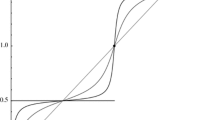Abstract
The aim of this paper is to contribute to the clarification of concepts usually found in books on quantum mechanics, aided by knowledge from the field of the theory of operators in Hilbert space. Frequently the basic distinction between bounded and unbounded operators is not established in books on quantum mechanics. It is repeatedly overlooked that the condition for an unbounded operator to be symmetric (Hermitian) is not sufficient to make it self-adjoint. To make things worse, nearly all operators in quantum mechanics are unbounded. Often one finds statements such as: For any linear operator A we can write a Hermitian operator HA=(A+A+)/2, where Hermitian is thought to mean self-adjoint. Along these lines, self-adjointness of the momentum operator in generalized coordinates, taken from that expression, is questioned. In particular, the redescription in terms of spherical polar coordinates and its implications for the eventual loss of self-adjointness of the momenta conjugate to them are studied.
Similar content being viewed by others
References
B. Simon,Quantum Mechanics for Hamiltonians Defined as Quadratic Forms (Princeton University Press, Princeton, New Jersey, 1971), p. 204.
R. D. Richtmeyer,Principles of Advanced Mathematical Physics (Springer, New York, 1978), Vol. I, Chapter 7.
M. Reed and B. Simon,Methods of Modern Mathematical Physics (Academic Press, New York, 1972), Vol. I, p. 255.
N. I. Akhiezer and I. M. Glazman,Theory of Linear Operators in Hilbert Space (Pitman, London, 1980), Vol. I, pp. 128 and 156.
F. Riesz and B. Sz-Nagy,Leçons d'Analyse Fonctionelle (Gauthier-Villars, Paris, 1972), 6th edn., p. 305;Functional Analysis (Ungar, New York, 1955).
M. Reed and B. Simon,Methods of Modern Mathematical Physics (Academic Press, New York, 1975), Vol. II, pp. 135.
B. DeWitt,Phys. Rev. 85, 653 (1952).
I. Stakgold,Boundary Value Problems of Mathematical Physics (Macmillan, New York, 1967), p. 145.
G. Hellwig,Differential Operators of Mathematical Physics (Addison-Wesley, Reading, Massachusetts, 1967), pp. 84 and 174.
B. Simon, inMathematics of Contemporary Physics, R. F. Streater, ed. (Academic Press, New York, 1972), p. 20.
G. R. Gruber,Found. Phys. 1, 227 (1971).
J. Weidmann,Linear Operators in Hilbert Spaces (Springer, New York, 1980), p. 73.
E. J. Saletan and A. H. Cromer,Theoretical Mechanics (Wiley, New York, 1971), p. 61.
I. S. Sokolnikoff,Tensor Analysis (Wiley, New York, 1964), p. 51.
P. A. M. Dirac,The Principles of Quantum Mechanics (Oxford University Press, Oxford, 1976), 4th edn., p. 153.
R. H. Dicke and J. P. Wittke,Introduction to Quantum Mechanics (Addison-Wesley, Reading, Massachusetts, 1963), p. 143.
Author information
Authors and Affiliations
Additional information
Partially supported by Fundação Calouste Gulbenkian, Lisboa.
Rights and permissions
About this article
Cite this article
Domingos, J.M., Caldeira, M.H. Self-adjointness of momentum operators in generalized coordinates. Found Phys 14, 147–154 (1984). https://doi.org/10.1007/BF00729971
Received:
Issue Date:
DOI: https://doi.org/10.1007/BF00729971




